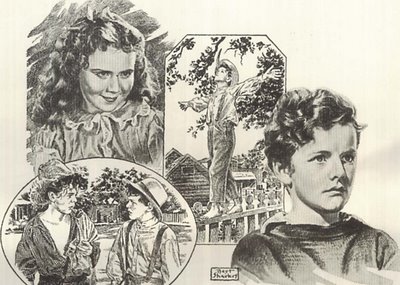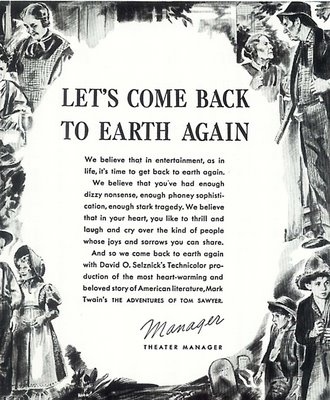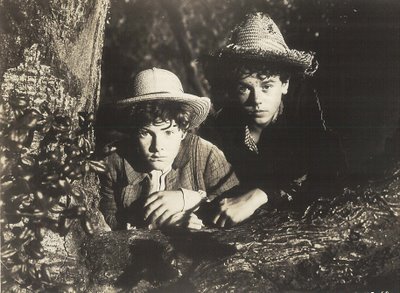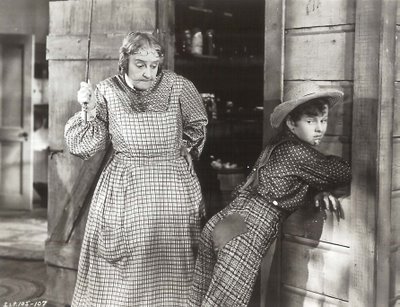
Favorites List --- The Adventures Of Tom Sawyer --- Part One

Just back from Myrtle Beach, SC, where I was reminded of an earlier trip to the shore with a church youth group back when I was sixteen. At a time when all the other kids were busy cruising the arcades, or worse, trying to score illicit beer and/or cigarettes, I spent our entire first afternoon closeted in the Rivoli Theatre watching (twice) David O. Selznick’s The Adventures Of Tom Sawyer. This being the summer of 1970, we were still a few years short of the dreadful Reader’s Digest remake that would star Family Affair’s Johnny Whitaker as Tom. I remember sitting there and marveling at the fact I was watching a 1938 Technicolor feature on the big screen. How could those other kids waste their time playing miniature golf when they could be in here watching this? The cave sequence had always packed a wallop for me on television. This time I sat and cried when Tom climbed those rocks to a sunlit opening, then returned to rescue Becky Thatcher. I still consider it one of the most dynamic scenes in movies. So why has the 1938 Tom Sawyer become such a bastard stepchild? He seemed to be everywhere during the sixties. In addition to re-issues, we had frequent syndicated runs on television. Sometimes Channel 8 would alternate the Selznick with Paramount’s early talking 1930 version featuring Jackie Coogan as Tom. It was one of the few vintage titles we had dependable access to. I wouldn’t realize until later what a troubled production this was, and how misused it had been ever since its original (and very disappointing) release.


 There were several false starts on The Adventures Of Tom Sawyer. Selznick had to begin with black-and-white in March of 1937 when Technicolor units proved unavailable. The process was gaining ground with the studios, and its limited equipment and resources were booked far ahead. Tom Sawyer’s initial director was H.C. Potter, who remained through one production shutdown (during April and May), but eventually quit as a result of Selznick’s ceaseless interference (a fact of life for all helmsmen at this company). Filming in B/W had resumed in June, but was again interrupted when Technicolor suddenly became available in July. Several cast members were replaced (including Beulah Bondi as Aunt Polly), but Selznick’s selection for the title role remained. Tommy Kelly was the non-professional son of an unemployed Bronx fireman (what … so they weren’t having fires anymore in the Bronx?). The twelve-year-old was paid a hundred dollars a week, and his father got a studio policeman job on the Selznick-International lot. The producer had hoped to draft his young players from orphan asylums (!), so as to arouse such a warm public feeling that it would add enormously to the gross of the picture (his memo), but eventually resorted to a cast of pro moppets, Tommy Kelly excepted. Everyone who had a contract with Selznick was expected to pitch in. Seasoned scribe Ben Hecht contributed draft revisions as he was completing Nothing Sacred, while George Cukor supposedly directed portions of the schoolhouse and pirate island segments. By now, Norman Taurog had been brought on as principal director, having had experience with kids on previous assignments. Previews of the completed Tom Sawyer brought screams from the kiddies and complaints from mothers. Seems those cave sequences were too intense, particularly the swarm of bats and Becky’s fits of hysteria. Selznick snipped an unusually horrible close-up of Becky laughing hysterically and in which her mind is obviously completely gone. He went on to observe that she looks like a little witch instead of a little girl. Though the bat attack was among his favorite scenes in the picture, the producer also had it shortened. Two days of retakes were ordered under William Wellman’s direction in December for a planned February 1938 opening.
There were several false starts on The Adventures Of Tom Sawyer. Selznick had to begin with black-and-white in March of 1937 when Technicolor units proved unavailable. The process was gaining ground with the studios, and its limited equipment and resources were booked far ahead. Tom Sawyer’s initial director was H.C. Potter, who remained through one production shutdown (during April and May), but eventually quit as a result of Selznick’s ceaseless interference (a fact of life for all helmsmen at this company). Filming in B/W had resumed in June, but was again interrupted when Technicolor suddenly became available in July. Several cast members were replaced (including Beulah Bondi as Aunt Polly), but Selznick’s selection for the title role remained. Tommy Kelly was the non-professional son of an unemployed Bronx fireman (what … so they weren’t having fires anymore in the Bronx?). The twelve-year-old was paid a hundred dollars a week, and his father got a studio policeman job on the Selznick-International lot. The producer had hoped to draft his young players from orphan asylums (!), so as to arouse such a warm public feeling that it would add enormously to the gross of the picture (his memo), but eventually resorted to a cast of pro moppets, Tommy Kelly excepted. Everyone who had a contract with Selznick was expected to pitch in. Seasoned scribe Ben Hecht contributed draft revisions as he was completing Nothing Sacred, while George Cukor supposedly directed portions of the schoolhouse and pirate island segments. By now, Norman Taurog had been brought on as principal director, having had experience with kids on previous assignments. Previews of the completed Tom Sawyer brought screams from the kiddies and complaints from mothers. Seems those cave sequences were too intense, particularly the swarm of bats and Becky’s fits of hysteria. Selznick snipped an unusually horrible close-up of Becky laughing hysterically and in which her mind is obviously completely gone. He went on to observe that she looks like a little witch instead of a little girl. Though the bat attack was among his favorite scenes in the picture, the producer also had it shortened. Two days of retakes were ordered under William Wellman’s direction in December for a planned February 1938 opening.
As is so often the case, favorite movies show up on DVD in other countries long before they reach us. Such is the case with The Adventures Of Tom Sawyer. There’s a Region 2 disc that’s been available for several years, and it’s the complete version all too rarely seen in this country (available HERE). Does anyone else share my longstanding affection for this show? To start with, I love the grim countenance shared by virtually all the adult authority figures surrounding Tom. They come across like authentic nineteenth-century figures --- quick with a hickory rod or a thimble thump to the head, cold and humorless otherwise. All seem rigid and repressed. Are these small-town denizens out of Mark Twain, or are they more reflective of the grown-up culture Selznick encountered in his boyhood days? Tom is routinely beaten, and none of it’s sugarcoated or played for laughs. Selznick never sidesteps the cruelties these adults visit upon children. Injun Joe is perhaps the most frightening villain in all 30’s film --- a nightmarish visage tempered not a whit by conscience or humanity. His pursuit of Tom and Becky in the cave is the equal of any horror sequence I’ve come across. Many of the settings (designed by William Cameron Menzies) are creepy in the extreme. His graveyard, caverns, austere schoolroom --- all cast a baleful shadow and go a long way toward maintaining tension. Humor in The Adventures Of Tom Sawyer is all the more effective as a counterbalance to the suspense. So many of the best comedies score with that combination (one that comes to mind is Some Like It Hot, similar in several respects to The Adventures Of Tom Sawyer). Tomorrow’s Part Two takes up the reception and rentals on T.A.O.T.S., as well as the extensive restoration that rescued the complete version after sixty plus years.